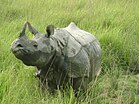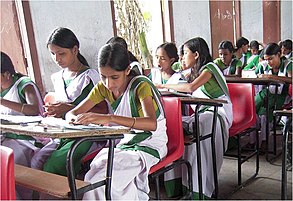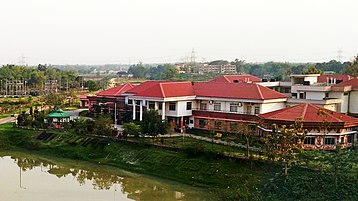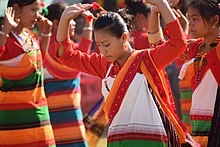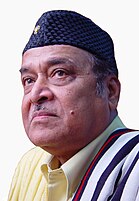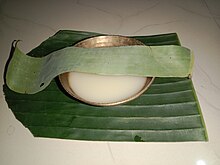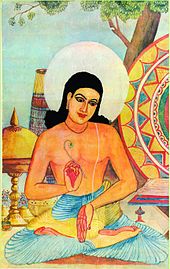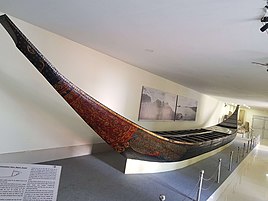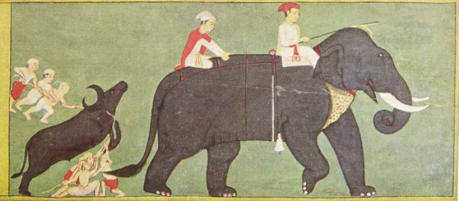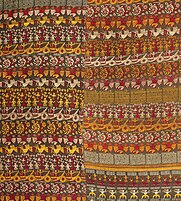Assam
Assam | |
|---|---|
| State of Assam | |
From top, left to right: Indian rhinoceros in Kaziranga National Park, Kamakhya Temple, IIT Guwahati, Rang Ghar, Indian elephants in Manas National Park, Majuli Island, Kareng Ghar in Garhgaon, Assam tea garden. | |
|
O Mur Apunar Dekh" (O my Dearest Country) | |
 Location of Assam in India | |
| Coordinates: 26°08′N 91°46′E / 26.14°N 91.77°E | |
| Country | |
| Region | Northeast India |
| Before was | State of Assam |
| Bifurcation | 21 January 1972 |
Formation | 26 January 1950[2] |
State Legislature | Unicameral |
| • Assembly | Assam Legislative Assembly (126 seats) |
| National Parliament | Parliament of India |
| • Rajya Sabha | 7 seats |
| • Lok Sabha | 14 seats |
| High Court | Gauhati High Court |
| Area | |
| • Total | 78,438 km2 (30,285 sq mi) |
| • Rank | Hollong |
| State highway mark | |
 | |
| State highway of Assam AS SH1 -AS SH48 | |
| List of Indian state symbols | |
| • First recognised as an administrative division on 1 April 1911, and led to the establishment of Assam Province by partitioning Province of East Bengal and Assam. • Assam was one of the original provincial divisions of British India. • Assam has had a legislature since 1937.[9] | |
Assam (
The state has 35
Etymology
The first dated mention of the region comes from
History
Pre-history
Assam and adjoining regions have evidences of human settlement from the beginning of the Stone Age. The hills at the height of 1,500 to 2,000 feet (460–615 m) were popular habitats probably due to availability of exposed dolerite basalt, useful for tool-making.[17]
Legend
According to a late text,
Ancient era
Evidence indicates presence of civilisation in Assam around 2nd century BCE, a rock cut stupa at
Medieval era
The Medieval Assam history may have started with the advent of
Chutia Kingdom
Kachari Kingdom
The
Ahom Kingdom
Early Period
The
For more than two and a half centuries, Sukapha and his descendants, while primarily focused on administering the kingdom, upheld their dominance in the valley through their military prowess.[27]
Expansion
The reign of Suhungmung marked the first massive expansion of Ahom kingdom. Besides sending a punitive expeditions against the Nagas, they fought numerous battles with the Bhuyans, Chutias, Kacharis, Turko-Afghans, and the Naras. In 1522-23 the Chutia Kingdom was annexed and the captured tract was placed under the administration of Sadiya-Khowa-Gohain. After securing the eastern tract, Suhungmung than expanded his kingdom westwards through conquest and extended it till Marangi to the west of the Dhansiri river. When the Kacharis tried to regain the lost territory they were defeated and their capital Dimapur was sacked. Over the remaining part of the Kachari kingdom, a new king Detsung was placed as a tributary, but Detsung proved disloyal and revolted against the Ahoms. He was subsequently executed. A new dependent king was set up on the Kachari throne with the name of Nirbhaynarayan. Since then the Kachari kings were regarded as 'thapita sanchita' meaning - established and maintained by the Ahom rulers.
Suhungmung's reign also witnessed the first Muslim-invasions of the kingdom. After a series of battle, the invaders were roundly defeated and were chased up to Karatoya River. The Sultan of Bengal, terrified by the approaching army of Suhungmung, made peace by offering his two daughters and five paraganas, along with other articles as dowry to the king. The rising Koch king Biswa Singha also offered his submission, and the Ahom general Ton-Kham granted him all the territories that were received as dowry from the Sultan of Bengal on the condition of annual tribute.[28]
The successors of Suhungmung, Suklenmung and Sukhaamphaa, sent many expeditions against the Bhuyans and Nagas. But were significant with the wars with the Koch. During the reign of Sukhaamphaa, the Ahoms lost to a Koch army led by Chilarai and the Ahoms had to accept Koch supremacy and had to give up the tracts of north of Brahmaputra. However, the lost tract was soon recovered with further military expeditions.[29]
Later Period
War with Mughals
Soon after the death of
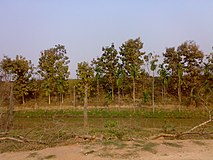
Soon after the departure of
The period after 1671 was very unstable due to the rivalry among the nobles, who wanted to arrest their own political power and influence by placing their own choice of prince in the throne. In 1679,
18th century
After
This finally resulted in the Moamoria rebellion (1769–1805), which greatly weakened the Ahom kingdom where the country was greatly depopulated and unorganised. The political rivalry between the nobles made a pathway for the Burmese to invade and weakened it more and finally leading to its annexation.
Colonial era

The discovery of
Despite the commercial success, tea labourers continued to be exploited, working and living under poor conditions. Fearful of greater government interference, the tea growers formed the Indian Tea Association in 1888 to lobby to retain the status quo. The organisation was successful in this, but even after India's independence, conditions of the labourers have improved very little.[34]
In the later part of the 18th century, religious tensions and atrocities by the nobles led to the Moamoria rebellion (1769–1805), resulting in tremendous casualties of lives and property. The rebellion was suppressed but the kingdom was severely weakened by the civil war. Political rivalry between Prime Minister Purnananda Burhagohain and Badan Chandra Borphukan, the Ahom Viceroy of Western Assam, led to an invitation to the Burmese by the latter,[35][36][37][38] in turn leading to three successive Burmese invasions of Assam. The reigning monarch Chandrakanta Singha tried to check the Burmese invaders but he was defeated after fierce resistance, which led to the Burmese occupation of Assam.[39][40][41]
A reign of terror was unleashed by the Burmese on the Assamese people,

Initially, Assam was made a part of the Bengal Presidency, then in 1906 it was made a part of Eastern Bengal and Assam province, and in 1912 it was reconstituted into a chief commissioners' province. In 1913, a legislative council and, in 1937, the Assam Legislative Assembly, were formed in Shillong, the erstwhile capital of the region. The British tea planters imported labour from central India adding to the demographic canvas.
The Assam territory was first separated from Bengal in 1874 as the 'North-East Frontier'
After a few initially unsuccessful attempts to gain independence for Assam during the 1850s, anti-colonial Assamese joined and actively supported the
The Assam Postage Circle was established by 1873 under the headship of the Deputy Post Master General.[53]
At the turn of the 20th century, British India consisted of eight provinces that were administered either by a governor or a lieutenant-governor. Assam Province was one among the major eight provinces of British India. The table below shows the major original provinces during British India covering the Assam Province under the Administrative Office of the Chief Commissioner.
With the partition of India in 1947, Assam became a constituent state of India. The Sylhet District of Assam (excluding the Karimganj subdivision) was given up to East Pakistan, which later became Bangladesh.
Modern history
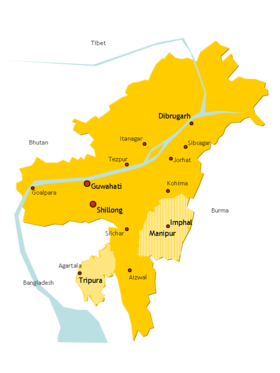
The government of India, which has the unilateral powers to change the borders of a state, divided Assam into several states beginning in 1970 within the borders of what was then Assam. In 1963, the Naga Hills district became the 16th state of India under the name of
Since the restructuring of Assam after independence, communal tensions and violence remain.
The post 1970s experienced the growth of armed separatist groups such as the
Deadly floods hit the state in
Geography

A significant geographical aspect of Assam is that it contains three of six physiographic divisions of India – The Northern Himalayas (Eastern Hills), The Northern Plains (Brahmaputra plain) and Deccan Plateau (Karbi Anglong). As the Brahmaputra flows in Assam the climate here is cold and there is rainfall most of the month. Geomorphic studies conclude that the Brahmaputra, the life-line of Assam, is an
Urban centres include Guwahati, one of the 100 fastest growing cities in the world.[59] Guwahati is also referred to as the "Gateway to the North-East India". Silchar, (in the Barak valley) is the second most populous city in Assam and an important centre of business. Other large cities include Dibrugarh, an oil and natural gas industry centre,[60]
Climate
With the tropical monsoon climate, Assam is temperate (summer max. at 95–100 °F or 35–38 °C and winter min. at 43–46 °F or 6–8 °C) and experiences heavy rainfall and high humidity.[58][61] The climate is characterised by heavy monsoon downpours reducing summer temperatures and affecting foggy nights and mornings in winters, frequent during the afternoons. Spring (March–April) and autumn (September–October) are usually pleasant with moderate rainfall and temperature. Assam's agriculture usually depends on the south-west monsoon rains.
Flooding
Every year, flooding from the Brahmaputra and other rivers such as Barak River etc. deluges places in Assam. The water levels of the rivers rise because of rainfall resulting in the rivers overflowing their banks and engulfing nearby areas. Apart from houses and livestock being washed away by flood water, bridges, railway tracks, and roads are also damaged by the calamity, which causes communication breakdown in many places. Fatalities are also caused by the natural disaster in many places of the State.[62][63]
Fauna
Assam is one of the richest
ecosystems; Many are now protected as national parks and reserved forests.Assam has wildlife sanctuaries, the most prominent of which are two UNESCO
Assam has conserved the one-horned
The state has the largest population of the wild water buffalo in the world.[70] The state has the highest diversity of birds in India with around 820 species.[71] With subspecies the number is as high as 946.[72] The mammal diversity in the state is around 190 species.[73]

Flora
Assam is remarkably rich in
Geology
Assam has
The region is prone to natural disasters like annual floods and frequent mild earthquakes. Strong earthquakes were recorded in 1869, 1897, and 1950.
Demographics
Population
| Year | Pop. | ±% |
|---|---|---|
| 1901 | 3,289,680 | — |
| 1911 | 3,848,617 | +17.0% |
| 1921 | 4,636,980 | +20.5% |
| 1931 | 5,560,371 | +19.9% |
| 1941 | 6,694,790 | +20.4% |
| 1951 | 8,028,856 | +19.9% |
| 1961 | 10,837,329 | +35.0% |
| 1971 | 14,625,152 | +35.0% |
| 1981 | 18,041,248 | +23.4% |
| 1991 | 22,414,322 | +24.2% |
| 2001 | 26,655,528 | +18.9% |
| 2011 | 31,205,576 | +17.1% |
| Source: Census of India[77] | ||
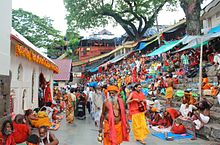
The total population of Assam was 26.66 million with 4.91 million households in 2001.[78] Higher population concentration was recorded in the districts of Kamrup, Nagaon, Sonitpur, Barpeta, Dhubri, Darrang, and Cachar. Assam's population was estimated at 28.67 million in 2006 and at 30.57 million in 2011 and is expected to reach 34.18 million by 2021 and 35.60 million by 2026.[79]
As per the 2011 census, the total population of Assam was 31,169,272. The total population of the state has increased from 26,638,407 to 31,169,272 in the last ten years with a growth rate of 16.93%.[80]
Of the 33 districts, Dhubri, Goalpara, Barpeta, Morigaon, Nagaon, and Hailakandi, recorded growth rates ranging from 20 per cent to 24 per cent during the last decade, whereas Sivasagar and Jorhat, registered around 9 per cent population growth. These districts do not have any international border.[81]

In 2011, the literacy rate in the state was 73.18%. The male literacy rate was 78.81% and the female literacy rate was 67.27%.[80] In 2001, the census had recorded literacy in Assam at 63.3% with male literacy at 71.3% and female at 54.6%. The urbanisation rate was recorded at 12.9%.[82]
The growth of population in Assam has increased since the middle decades of the 20th century. The population grew from 3.29 million in 1901 to 6.70 million in 1941. It increased to 14.63 million in 1971 and 22.41 million in 1991.[78] The growth in the Western districts and Southern districts was high primarily due to the influx of large number of illegal immigrants from East Pakistan, now Bangladesh.[56]
The mistrust and clashes between indigenous Assamese people and
The People of India project has studied 115 of the ethnic groups in Assam. 79 (69%) identify themselves regionally, 22 (19%) locally, and 3 trans-nationally. The earliest settlers were
Religions
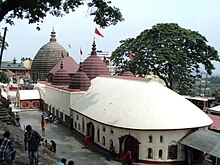
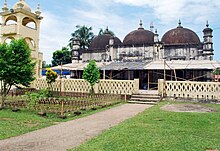
Religion in Assam (2011)[89]

According to the
The three popular sects of Hinduism, namely,
| Religion | Population |
|---|---|
| Hindus ( |
19,180,759 |
| Muslims ( |
10,679,345 |
| Christians ( |
1,165,867 |
| ) | 54,993 |
| ) | 25,949 |
| Sikhs ( |
20,672 |
| Other religions | 27,118 |
| Not stated/available | 50,873 |
| Total | 31,205,576 |
Out of 32 districts of Assam, 9 are Muslim majority according to the 2011 census of India. The districts are Dhubri, Goalpara, Barpeta, Morigaon, Nagaon, Karimganj, Hailakandi, Darrang and Bongaigaon.[94][95][96]
Languages

| Language | Population |
|---|---|
| Assamese | 15,097,257 |
| Bengali | 9,024,652 |
Bodo
|
1,407,371 |
Hindi
|
1,001,698 |
| Sadri | 714,607 |
Mishing
|
617,870 |
| Nepali | 596,026 |
| Karbi | 511,771 |
| Others | 2,234,319 |
| Total | 31,205,576 |

According to the language census of 2011 in Assam, out of a total population of around 31 million, Assamese is spoken by more than 22 million total speakers, with more than 15 million people speaking it as their

The various
The population of the Brahmaputra Valley is 27,580,977 according to the 2011 census report by the Assam government. Assamese is the official language of the Brahmaputra Valley and is spoken by 15 million people comprising 55.65% of the valley population. Bengali is spoken by 6.09 million people representing 22.1% of the valley, Hindi is spoken by 2.1 million comprising 7.61% of the region, Bodo is spoken by 1.41 million comprising 5.13% of the valley's population and 2.98 million people speak various indigenous tribal languages of Assam, such as
, Halam, Ao and Motak.Traditionally, Assamese was the language of the common folk in the ancient
Linguistically modern Assamese traces its roots to the version developed by the American Missionaries based on the local form used near Sivasagar (Xiwôxagôr) district. Assamese (Ôxômiya) is a rich language due to its hybrid nature and unique characteristics of pronunciation and softness. The presence of Voiceless velar fricative in Assamese makes it a unique among other similar Indo-Aryan languages.[118][119]
There are approximately 590,000 Nepali speakers spread all over the state forming about 1.98% of Assam's total population according to 2011 census.
There are speakers of Tai languages in Assam. A total of six Tai languages were spoken in Assam. Two are now extinct.[120]
Government and politics
Assam has Governor
On 19 May 2016,
Administrative districts
The 31 administrative districts of Assam are delineated based on geographic features such as rivers, hills, and forests.
On 15 August 2015, five new districts were formed:[123][124]
- Part of Sonitpur became the Biswanath district (9 in the nearby map)
- Part of Sivasagar became the Charaideo district (4)
- Part of Nagaon became the Hojai district (14)
- Part of Dhubri became the South Salmara-Mankachar district (33)
- The Karbi Anglong district was divided into East (11) and West (15) districts
On 27 June 2016, an island in the Brahmaputra River was bifurcated from the Jorhat district and declared the Majuli district, India's first district that is a river island.[125]
On 12 January 2021, Bajali was carved out from Barpeta district and formally declared as a district. With the announcement made by Governor Jagdish Mukhi, it has become the 34th district of Assam.[126]
On 31 December 2022, existing four districts Bajali (with Barpeta), Tamulpur(with Udalguri), Biswanath (with Sonitpur) and Hojai(with Nagaon) and number of district came down to 31.
However, after the delimitation exercise was carried out in Assam, the Assam Cabinet reconstituted the 4 new districts (Bajali, Tamulpur, Biswanath and Hojai), taking the number of districts to 35 again.
Subdivisions
The administrative districts are further subdivided into 54 "Subdivisions" or
The
For revenue purposes, the districts are divided into revenue circles and mouzas; for the development projects, the districts are divided into 219 'development-blocks' and for law and order these are divided into 206 police stations or thana.
A list of 9 oldest, classified and prominent, and constantly inhabited, recognised urban centres based on the earliest years of formation of the civic bodies, before the
| Oldest recognised urban centres of Assam[129] | ||||||||
|---|---|---|---|---|---|---|---|---|
| Urban Centres | Civic Body | Year | Airport | Railway Station | Railway Junction | Road Networks | Category† | Notes |
| Guwahati | Guwahati Town Committee | 1853 | Yes | Yes | Yes | Yes | Tier – III | More
Guwahati, the first township of Assam.[130] |
| Guwahati Municipal Board | 1873↑ | Yes | Yes | Yes | Yes | Tier – II | ||
| Guwahati Municipal Corporation | 1974↑ | Yes | Yes | Yes | Yes | Tier – I | More
Establishment of Guwahati Municipal Corporation.[131] | |
| Dibrugarh | Dibrugarh Municipal Board |
1873 | Yes | Yes | Yes | Yes | Tier – II | More
Dibrugarh, the second township of Assam.[132] |
| Goalpara | Goalpara Municipal Board | 1875 | No 1 | Yes | No 2 | Yes | Tier – II | More
Formation of Goalpara Municipality, 1875.[133] |
| Dhubri | Dhubri Municipal Board | 1883 | Yes | Yes | Yes | Yes | Tier – II | More
Formation of Dhubri Municipality, 1883.[134] |
| Nagaon | Nagaon Municipal Board | 1893 | No 3 | Yes | Yes | Yes | Tier – II | More
Formation of Nagaon Municipality, 1893.[135] |
| Tezpur | Tezpur Municipal Board | 1894 | Yes | Yes | Yes | Yes | Tier – II | More
Formation of Tezpur Municipality, 1894.[136] |
| Jorhat | Jorhat Municipal Board | 1909 | Yes | Yes | Yes | Yes | Tier – II | More
Formation of Jorhat Municipality, 1909.[137] |
| Golaghat | Golaghat Municipal Board | 1920 | No 4 | Yes | Yes | Yes | Tier – II | More
Formation of Golaghat Municipality, 1920.[138] |
| Silchar | Silchar Municipal Board | 1922 | Yes | Yes | Yes | Yes | Tier – II | More
Formation of Silchar Municipality, 1922.[139] |
| †Tier – I: a big city with an with a sizeable human settlement. ↑Upgraded to the next highest form of civic body. | ||||||||
Autonomous Council
The state has three autonomous councils under the sixth schedule of the Indian Constituition.
- Bodoland Autonomous Territorial Council
- Karbi Anglong Autonomous Council.
- Dima Hasao Autonomous Council.
The state has further statutory autonomous councils constituted under State Act-
- Tiwa people(Lalung)
- Rabha Hasong Autonomous Council
- Mising Autonomous Council for Mising people
- Deori Autonomous Council
- Sonowal Kachari Autonomous Council for Sonowal Kachari people
- Thengal Kachari Autonomous Council
- Moran Autonomous Council for Moran people
- Dudhnoi for ethnic Rabha Kachari
- Mising Autonomous Council for Mising people
- Matak Autonomous Council for Matak people
- Rajbongshi people
- Bodo-Kachari people living outside the Bodoland Territorial Region
In March 2024, the Assam cabinet had given green signal for 'Kiran Sheikh' development council for the 'Kiran Sheikh' community in Barak Valley.[140]
Social issues
Inter-state dispute

According to Assam Government, Assam has border dispute with four states namely Meghalaya, Mizoram, Nagaland, Arunachal Pradesh.[141]
Assam-Mizoram dispute
Assam-Meghalaya dispute
Meghalaya has identified close to a dozen areas on which it has a dispute with Assam about the state's borders. The chief ministers of the two states, Himanta Biswa Sarma and Megahalya's Conrad Sangma, recently held the first-ever meeting on inter-state border dispute. Both the states have agreed to individually assess the claims for all 12 areas flagged by Meghalaya in the past. A second round of discussion between the two state CMs will be held next month of August. On the question of the role the Union Government is playing in redressing the inter-State border dispute in the country, minister of state for home affairs Nityanand Rai said, "The approach of the Central Government has consistently been that inter-state disputes can be resolved only with the cooperation of the State Governments concerned and that the Central Government acts only as a facilitator for amicable settlement of the dispute in the spirit of mutual understanding."[141]
Assam-Nagaland dispute
The border dispute between the two states has been going on since the formation of Nagaland in 1963. The two states lay claim to Merapani, a small village next to the plains of Assam's Golaghat district. There have been reports of violent clashes in the region since the 1960s.[141][143]
Assam-Arunachal Pradesh dispute
Assam shares an 804.10 km inter-state boundary with
Separate statehood demand within Assam
Ahomland

Barak state

The
Bodoland

The agitation for the creation of a separate
Dimaraji

The Dimasa people of northeast India have been demanding a separate state called Dimaraji or "Dimaland" for several decades. It would comprise the Dimasa-Kachari inhabited areas, namely Dima Hasao district, Cachar district, parts of Barak Valley, Nagaon district, Hojai district and Karbi Anglong district in Assam together with part of Dimapur district in Nagaland.
Karbiland

Migration from Bangladesh
Assam has been a major site of migration since the
Besides migration caused by displacement, there is also a large and continual unregulated movement between Assam and neighbouring regions of Bangladesh with an exceptionally porous border. The situation is called a risk to Assam's as well as India's security.
The 1991 census made the changing demographics of border districts more visible.[178][175] Since 2010, the Indian Government has undertaken the updating of the National Register of Citizens for Assam, and in 2018 the 32.2 million residents of Assam were subject to a review of their citizenship.[179] In August 2019, India released the names of the 2 million residents of Assam that had been determined to be non-citizens and whose names had therefore been struck off the Register of Citizens, depriving them of rights and making them subject to action, and potentially leaving some of them stateless, and the government has begun deporting non-citizens, while detaining 1,000 others that same year.[180][181][182]
In January 2019, the Assam's peasant organisation
In February 2020, the Assam Minority Development Board announced plans to segregate illegal Bangladeshi Muslim immigrants from the indigenous Muslims of the state, though some have expressed problems in identifying an indigenous Muslim person. According to the board, there are 1.4 crore Muslims in the state, of which 1 crore are of Bangladeshi origin.[188][189][190] A report reveals that out of total 33 districts in Assam, Bangladeshis dominate almost 15 districts of Assam.[191][192][193]
Floods
In the rainy season every year, the Brahmaputra and other rivers overflow their banks and flood adjacent land. Flood waters wash away property including houses and livestock. Damage to crops and fields harms the agricultural sector. Bridges, railway tracks, and roads are also damaged, harming transportation and communication, and in some years requiring food to be air-dropped to isolated towns. Some deaths are attributed to the floods.[194][195]
Unemployment
Unemployment is a chronic problem in Assam. It is variously blamed on poor infrastructure, limited connectivity, and government policy;[196] on a "poor work culture";[197] on failure to advertise vacancies;[198] and on government hiring candidates from outside Assam.[199]
In 2020 a series of violent lynchings occurred in the region.
Education
-
School girls in the classroom, Lakhiganj High School, Assam
-
Academic complex of IIT Guwahati
Assam schools are run by the Indian government, government of Assam or by private organisations. Medium of instruction is mainly in Assamese, English or Bengali. Most of the schools follow the state's examination board which is called the
Assamese language is the main medium in educational institutions but Bengali language is also taught as a major Indian language. In Guwahati and Digboi, many Jr. basic schools and Jr. high schools are Nepali linguistic and all the teachers are Nepali. Nepali is included by Assam State Secondary Board, Assam Higher Secondary Education Council and Gauhati University in their HSLC, higher secondary and graduation level respectively. In some junior basic and higher secondary schools and colleges, Nepali teachers and lecturers are appointed.[citation needed]
The capital, Dispur, contains institutions of higher education for students of the north-eastern region. Cotton College, Guwahati, dates back to the 19th century. Assam has several institutions for tertiary education and research.[citation needed]
Universities, colleges and institutions include:
Universities
- Assam University
- Assam Agricultural University, Jorhat
- Assam Don Bosco University,[200]
- Assam down town University,[201]
- Assam Rajiv Gandhi University of Cooperative Management, (ARGUCOM), Sivasagar
- Assam Science and Technology University,[202] Guwahati
- Assam Women's University,[203] Jorhat
- Bodoland University,[204] Kokrajhar
- Cotton University, Guwahati
- Dibrugarh University,[205] Dibrugarh
- Gauhati University,[206] Guwahati
- Kaziranga University,[207] Jorhat
- Krishnaguru Adhyatmik Vishvavidyalaya
- Krishna Kanta Handique State Open University
- Kumar Bhaskar Varma Sanskrit and Ancient Studies University
- Mahapurusha Srimanta Sankaradeva Viswavidyalaya
- National Law University and Judicial Academy, Assam[208]
- Royal Global University
- Srimanta Sankaradeva University of Health Sciences
- Tezpur University,[209] Tezpur
Medical colleges
- AIIMS, Guwahati
- Assam Medical College, Dibrugarh
- Gauhati Medical College and Hospital, Guwahati
- Jorhat Medical College and Hospital, Jorhat
- Diphu Medical College and Hospital, Diphu
- Lakhimpur Medical college and Hospital, Lakhimpur
- Silchar Medical College and Hospital, Silchar
- Tezpur Medical College & Hospital, Tezpur
- Fakhruddin Ali Ahmed Medical College, Barpeta
- Nagaon Medical College and Hospital, Nagaon
- Kokrajhar Medical College and Hospital, Kokrajhar
- Dhubri Medical College and Hospital, Dhubri
- Regional Dental College, Guwahati
- Government Dental College, Silchar
Assam has 12 medical colleges at present with 4 more scheduled to be completed by 2026–27.
Engineering and technological colleges
- Indian Institute of Information Technology, Guwahati
- National Institute of Technology, Silchar,[211]
- Assam Engineering College, Guwahati[212]
- Assam Science and Technology University
- Bineswar Brahma Engineering College, Kokrajhar
- Central Institute of Technology, Kokrajhar[213]
- Girijananda Chowdhury Institute of Management and Technology, Guwahati[214]
- Girijananda Chowdhury Institute of Management and Technology, Tezpur
- Institute of Engineering and Technology, Dibrugarh University
- Institute of Science and Technology, Guwahati University
- Jorhat Engineering College, Jorhat[215]
- Jorhat Institute of Science & Technology, Jorhat
- NETES Institute of Technology & Science Mirza, [citation needed]
- Barak Valley Engineering College Nirala Karimganj
- Golaghat Engineering College, Golaghat
Research institutes present in the state include National Research Centre on Pig, (ICAR) in Guwahati,[216]
Economy
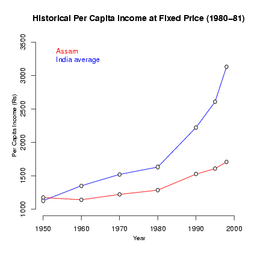
Assam's economy is based on agriculture and oil. Assam produces more than half of India's tea.[217] The Assam-Arakan basin holds about a quarter of the country's oil reserves, and produces about 12% of its total petroleum.[218] According to the recent estimates,[219] Assam's per capita GDP is ₹6,157 at constant prices (1993–94) and ₹10,198 at current prices; almost 40% lower than that in India.[220] According to the recent estimates,[219] per capita income in Assam has reached ₹6756 (1993–94 constant prices) in 2004–05, which is still much lower than India's.

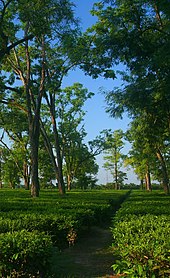
Tea plantations
Macro-economy
The economy of Assam today represents a unique juxtaposition of backwardness amidst plenty.[221][full citation needed] Despite its rich natural resources, and supplying of up to 25% of India's petroleum needs, Assam's growth rate has not kept pace with that of India; the difference has increased rapidly since the 1970s.[222] The Indian economy grew at 6% per annum over the period of 1981 to 2000; the growth rate of Assam was only 3.3%.[223] In the Sixth Plan period, Assam experienced a negative growth rate of 3.78% when India's was positive at 6%.[222] In the post-liberalised era (after 1991), the difference widened further.
According to recent analysis, Assam's economy is showing signs of improvement. In 2001–02, the economy grew (at 1993–94 constant prices) at 4.5%, falling to 3.4% in the next financial year.[224] During 2003–04 and 2004–05, the economy grew (at 1993–94 constant prices) at 5.5% and 5.3% respectively.[224] The advanced estimates placed the growth rate for 2005–06 at above 6%.[219] Assam's GDP in 2004 is estimated at $13 billion in current prices. Sectoral analysis again exhibits a dismal picture. The average annual growth rate of agriculture, which was 2.6% per annum over the 1980s, has fallen to 1.6% in the 1990s.[225] The manufacturing sector showed some improvement in the 1990s with a growth rate of 3.4% per annum than 2.4% in the 1980s.[225] For the past five decades, the tertiary sector has registered the highest growth rates of the other sectors, which even has slowed down in the 1990s than in the 1980s.[225]
Employment
Unemployment is one of the major problems in Assam. This problem can be attributed to overpopulation and a faulty education system. Every year, large numbers of students obtain higher academic degrees but because of non-availability of proportional vacancies, most of these students remain unemployed.[226][227] A number of employers hire over-qualified or efficient, but under-certified, candidates, or candidates with narrowly defined qualifications. The problem is exacerbated by the growth in the number of technical institutes in Assam which increases the unemployed community of the State. Many job-seekers are eligible for jobs in sectors like railways and Oil India but do not get these jobs because of the appointment of candidates from outside of Assam to these posts. The reluctance on the part of the departments concerned to advertise vacancies in vernacular language has also made matters worse for local unemployed youths particularly for the job-seekers of Grade C and D vacancies.[228][229]
Reduction of the unemployed has been threatened by illegal immigration from Bangladesh. This has increased the workforce without a commensurate increase in jobs. Immigrants compete with local workers for jobs at lower wages, particularly in construction, domestics, Rickshaw-pullers, and vegetable sellers.[230][231] The government has been identifying (via NRC) and deporting illegal immigrants. Continued immigration is exceeding deportation.[232][233]
Agriculture

In Assam among all the productive sectors, agriculture makes the highest contribution to its domestic sectors, accounting for more than a third of Assam's income and employs 69% of workforce.[234] Assam's biggest contribution to the world is Assam tea. It has its own variety, Camellia sinensis var. assamica. The state produces rice, rapeseed, mustard seed, jute, potato, sweet potato, banana, papaya, areca nut, sugarcane and turmeric.[citation needed]
Assam's agriculture is yet to experience modernisation in a real sense. With implications for food security, per capita food grain production has declined in the past five decades.[235] Productivity has increased marginally, but is still low compared to highly productive regions. For instance, the yield of rice (a staple food of Assam) was just 1531 kg per hectare against India's 1927 kg per hectare in 2000–01[235] (which itself is much lower than Egypt's 9283, US's 7279, South Korea's 6838, Japan's 6635 and China's 6131 kg per hectare in 2001[236]). On the other hand, after having strong domestic demand, and with 1.5 million hectares of inland water bodies, numerous rivers and 165 varieties of fishes,[237] fishing is still in its traditional form and production is not self-sufficient.[238]
Floods in Assam greatly affect the farmers and the families dependent on agriculture because of large-scale damage of agricultural fields and crops by flood water.
Infrastructure
On 30 August 2023, Nilachal Flyover was inaugurated. The flyover is Assam's longest flyover, spanning 2.63 kilometres and connecting Maligaon Chariali to Kamakhya Gate in Guwahati.[241]
Industry
Handlooms and handicrafts are traditional industries that continue to survive, especially among rural women, in the state.[242]
Assam's proximity to some neighbouring countries such as Bangladesh, Nepal and Bhutan, benefits its trade. The major
The government of India has identified some thrust areas for industrial development of Assam:[244]
- Petroleum and natural gas-based industries
- Industries based on locally available minerals
- Processing of plantation crops
- Food processing industries
- Agri-Horticulture products
- Herbal products
- Biotech products
- Pharmaceuticals
- Chemical and plastic-based industries
- Export oriented industries
- Electronic and IT base industries including services sector
- Paper making industries
- Textiles and sericulture
- Engineering industries
- Cane and bamboo-based industries
- Other handicrafts industry
Although, the region in the eastern periphery of India is landlocked and is linked to the mainland by the narrow
Assam is a producer of
There are several other industries, including a chemical
Tourism
Wildlife, cultural, and historical destinations have attracted visitors.
Culture

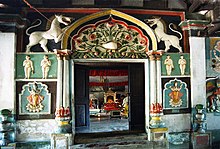
- Assimilation in the Kamarupa Kingdom for almost 800 years (Varman dynasty for 300 years, Mlechchha dynasty for 250 years and the Pala dynasty for 200 years.[17]
- Establishment of the Chutia kingdom in the 12th century in eastern Assam and assimilation for next 400 years.[17]
- Establishment of the Ahom kingdom in the 13th century CE and assimilation for next 600 years.[17]
- Assimilation in the Koch Kingdom (15th–16th century CE) of western Assam and Kachari Kingdom (12th–18th century CE) of central and southern Assam.[17]
- sattra (the Vaishnav Monasteries) have become an integral part of the Assamese way of life. The movement contributed greatly towards language, literature, and performing and fine arts.[citation needed]. It was also an egalitarian reform movement as it broke away with the old caste barriers of Brahmanical Hinduism and converted into its fold people of all castes, ethnicity and religions (including Islam).
The modern culture has been influenced by events in the British and the post-British era.
Increasing efforts of standardisation in the 20th century alienated the localised forms present in different areas and with the less-assimilated
. It is important to keep the broader system closer to its roots and at the same time focus on development of the sub-systems.Some of the common and unique cultural traits in the region are peoples' respect towards
Symbols

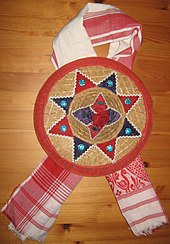
Symbolism is an ancient cultural practice in Assam and is still a very important part of the Assamese way of life. Various elements are used to represent beliefs, feelings, pride, identity, etc.
Tamulpan (areca nut and betel leaves), Xorai and Gamosa are three important symbolic elements in Assamese culture. Tamulpan or guapan (gua from kwa) are considered along with the Gamosa (a typical woven cotton or silk cloth with embroidery) as the offers of devotion, respect and friendship. The Tamulpan-tradition is an ancient one and is being followed since time-immemorial with roots in the aboriginal Austric culture. Xorai is a traditionally manufactured bell-metal article of great respect and is used as a container-medium while performing respectful offers. Moreover, symbolically many ethno-cultural groups use specific clothes to portray respect and pride.
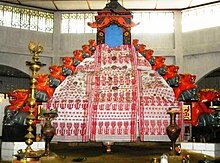
There were many other symbolic elements and designs, but are now only found in literature, art, sculpture, architecture, etc. or in use today for only religious purposes. The typical designs of Assamese-lion, dragon (ngi-ngao-kham), and flying-lion (Naam-singho) are used for symbolising various purposes and occasions. The archaeological sites such as the Madan Kamdev (c. 9th–10th centuries CE) exhibits mass-scale use of lions, dragon-lions and many other figures of demons to show case power and prosperity.

The Vaishnavite monasteries (Sattras) and many other architectural sites of the late medieval period display the use of lions and dragons for symbolic effects.

